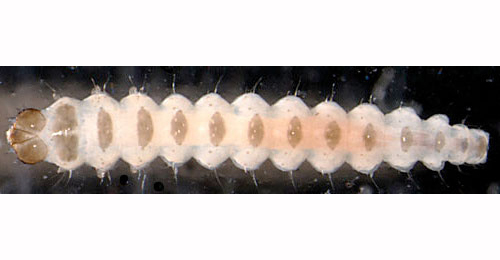|
||||||
|
Acrocercops
brongniardella (Fabricius, 1798) Elm Bent-wing Tinea brongniardella Fabricius, 1798. Suppl. Ent. Syst.: 496 Acrocercops brongniardella (Fabricius, 1798). |
||||||||||||||||||||||||||||||||||||||||||||||||||
Leaf-mine: A silvery sinuous gallery on the upper side, leading to a large, papery blotch. Sometimes several galleries lead to the same blotch (British leafminers). The mine begins as a rather tortuous upper surface, epidermal, corridor. As a rule several mines on a leaf, and when the corridors widen they coalcesce into one white epidermal blotch. After a moult the larvae start feeding from the palissade parenchyma that forms the floor of their communal mine, which is not widened any more. Pupation outside the mine (Bladmineerders van Europa). Larva: The larvae of moths have a head capsule and chewing mouthparts with opposable mandibles (see video of a gracillarid larva feeding), six thoracic legs and abdominal legs (see examples). The larva is illustrated in Bladmineerders van Europa. |
||||||||||||||||||||||||||||||||||||||||||||||||||
|
||||||||||||||||||||||||||||||||||||||||||||||||||
Pupa: The pupae of moths have visible head appendages, wings and legs which lie in sheaths (see examples). The pupa is in a silken cocoon amongst detritus; occasionally inside mine (British leafminers). Adult: The adult is illustrated in UKMoths. The species is included in mothdissection.co.uk. Hosts in Great Britain and Ireland: |
||||||||||||||||||||||||||||||||||||||||||||||||||
|
||||||||||||||||||||||||||||||||||||||||||||||||||
| Hosts elsewhere: | ||||||||||||||||||||||||||||||||||||||||||||||||||
|
||||||||||||||||||||||||||||||||||||||||||||||||||
Time of year - larvae: May - June (British leafminers). Time of year - adults: End of July. It can also overwinter and be found again in April and May (UKMoths). Distribution in Great Britain and Ireland: Widespread in Britian including Bedfordshire, Caernarvonshire, Cambridgeshire, Denbighshire, Dorset, East Cornwall, East Norfolk, East Suffolk, Glamorgan, Hertfordshire, Huntingdonshire, Isle of Wight, Middlesex, North Ebudes, North Essex, North Hampshire, North Somerset, North Wiltshire, Shropshire, South Hampshire, South Wiltshire, South-west Yorkshire, Stafford, Surrey, West Gloucestershire, West Norfolk, West Suffolk and Worcestershire (NBN Atlas) and the Channel Islands. Also Fleet, Hampshire (British leafminers). See also British leafminers distribution map. Also recorded in the Northern Ireland (CEDAR database, pers. com. John McClean) and Republic of Ireland (Fauna Europaea, UKMoths, National Biodiversity Data Centre Map). |
||||||||||||||||||||||||||||||||||||||||||||||||||
Distribution elsewhere: Widespread in continental Europe including Austria, Belarus, Belgium, Bulgaria, Corsica, Croatia, Czech Republic, Danish mainland, Finland, French mainland, Germany, Greek mainland, Hungary, Italian mainland, Latvia, Luxembourg, Macedonia, Norwegian mainland, Poland, Portuguese mainland, Romania, Russia - Central, East, Northwest and South, Sardinia, Sicily, Slovakia, Spanish mainland, Sweden, Switzerland, The Netherlands and Ukraine (Fauna Europaea). NBN Atlas links to known host species:
British and Irish Parasitoids in Britain and elsewhere:
|
||||||||||||||||||||||||||||||||||||||||||||||||||
| Last updated 09-Oct-2019 Brian Pitkin | ||

